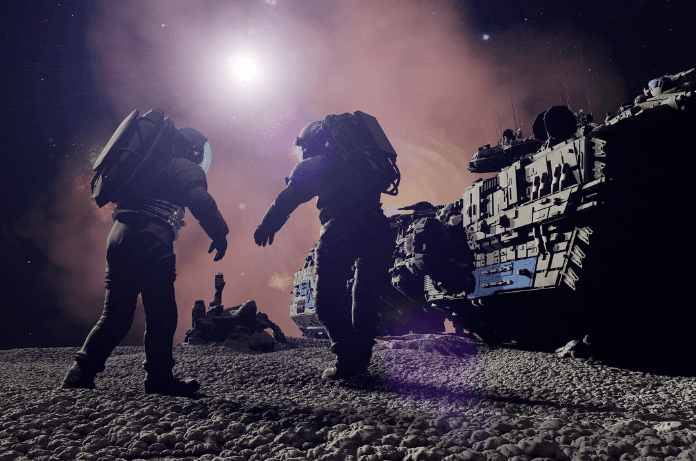Imagine floating above Earth, tethered to a spacecraft, with nothing but the vast emptiness of space surrounding you. Now, imagine doing this for over nine hours, facing both the physical and mental challenges of being outside your ship, while the world watches your every move. Sounds intense, right? Well, that’s exactly what Chinese astronauts Cai Xuzhe and Song Lingdong accomplished recently aboard the Tiangong space station, setting a new world record for the longest single spacewalk.
This awe-inspiring feat not only shatters a record that stood for over 23 years but also marks a significant milestone in China’s ambitious journey to dominate space exploration. Let’s dive into this incredible achievement, the technology that made it possible, and what it means for the future of space missions.
A Nine-Hour Marathon in Space
As per CGTN, On a cool Tuesday evening, precisely at 9:57 pm Beijing time, Cai Xuzhe and Song Lingdong wrapped up a staggering 9-hour extravehicular activity (EVA). Their mission? To perform maintenance tasks outside the Tiangong space station. This daring EVA officially eclipsed the previous record of 8 hours and 56 minutes, set by NASA astronauts James Voss and Susan Helms during a 2001 mission to the International Space Station (ISS).
The feat was no small task. Staying outside the protective confines of a spacecraft for such an extended period requires immense physical stamina, mental focus, and, of course, cutting-edge technology. The China Manned Space Agency (CMSA) hailed the mission as a “full success,” and for good reason, it was a perfect blend of human courage and technological excellence.
The Tech Behind the Triumph
The success of this record-breaking spacewalk owes much to the second-generation ‘Feitian’ spacesuits. These suits are designed to support astronauts for up to 8 hours of external work, a substantial improvement over their predecessors. The original Feitian suits, used during China’s first spacewalk in 2008, could only support brief activities lasting around 20 minutes.
These new suits not only offer extended operational time but also better protection and mobility. As China pushes the boundaries of space exploration, such innovations are crucial for longer, more complex missions.
A Historic First for Song Lingdong
For Song Lingdong, this spacewalk was a particularly momentous achievement. Born in the 1990s, Song became the first Chinese astronaut of his generation to perform a spacewalk. Before joining the space program, Song was a fighter pilot with the People’s Liberation Army Air Force, a background that clearly prepared him for high-stakes operations in space.
Completing a nine-hour EVA on his first spacewalk is nothing short of remarkable. His resilience and composure mark him as a rising star in China’s growing team of astronauts.
Cai Xuzhe: A Veteran in the Spotlight
For mission commander Cai Xuzhe, this wasn’t his first dance in the vacuum of space. Cai had previously completed a 5.5-hour EVA in November 2022 during the Shenzhou-14 mission. That mission was significant in itself, marking the first spacewalk after the Tiangong Space Station achieved its T-shaped configuration in low Earth orbit.
Cai’s experience and leadership played a crucial role in ensuring the success of this latest mission. His calm demeanor and expertise underscore China’s commitment to training astronauts capable of handling extended, high-risk operations.
China’s Spacewalk Journey: From 20 Minutes to 9 Hours
China’s spacewalk history began with astronaut Zhai Zhigang in September 2008. During the Shenzhou-7 mission, Zhai spent just under 20 minutes outside his spacecraft, a groundbreaking achievement for China at the time. Fast-forward to 2024, and the nation is now pushing the limits with record-breaking EVAs lasting over 9 hours.

The rapid advancements in technology, especially the development of the second-generation Feitian suits, reflect China’s serious investment in space exploration. Each mission builds on the last, paving the way for even more ambitious endeavors, including future lunar landings.
Teamwork Makes the Dream Work
Such achievements don’t happen in isolation. The success of Cai Xuzhe and Song Lingdong’s spacewalk was a testament to seamless teamwork. While the duo braved the void, their crewmate Wang Haozhe remained inside the Tiangong station, coordinating with ground control teams. The station’s robotic arms also played a crucial role, assisting the astronauts and ensuring safety throughout the mission.
This level of coordination and mutual support highlights how space exploration is the ultimate team effort. Without flawless communication and planning, such daring feats would be impossible.
What’s Next for the Shenzhou-19 Mission?
The Shenzhou-19 mission, which began in late October 2024, is far from over. The astronauts are expected to conduct additional EVAs, perform numerous scientific experiments, and carry out technical tests that will further China’s space station development. The mission is scheduled to conclude in April or May 2025, with the crew landing in Inner Mongolia.
But China isn’t stopping there. With eyes set on becoming the second nation to land on the moon, after the United States, China is developing specialized spacesuits and preparing for a lunar mission by 2030.
A Bold Future for China’s Space Exploration
Earlier this year, astronauts Ye Guangfu and Li Guangsu from the Shenzhou-18 mission set the stage by completing an 8-hour and 23-minute EVA. Now, Cai Xuzhe and Song Lingdong have taken things a step further and rewrote the 23-year history by completing 9 hours of EVA. Each milestone brings China closer to its goal of becoming a dominant force in space.
With investments in cutting-edge technology, ambitious lunar missions, and a new generation of skilled astronauts, China’s space future looks incredibly bright.

